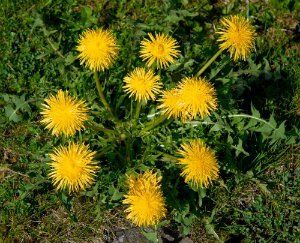Description: The Common Dandelion, scientifically known as Taraxacum officinale, is a perennial herbaceous plant belonging to the Asteraceae family. Recognizable by its distinctive yellow flowers and characteristic pinnately lobed leaves, the dandelion is a widespread and adaptable plant found in various environments around the world.
Habitat and Distribution: Dandelions are highly adaptable and can be found in a wide range of habitats, including lawns, meadows, fields, and disturbed areas. They are native to Europe and Asia but have naturalized in North America and other regions. Dandelions are known for their resilience and ability to thrive in diverse climates and soil conditions.
Physical Features: Leaves: Dandelion leaves form a rosette, and they are deeply lobed, creating a distinctive toothed appearance. The leaves contain a milky latex sap.
Flowers: The bright yellow flowers of the dandelion are composed of numerous small florets arranged in a composite head. The flowers are supported by a hollow, leafless stem.
Seeds: Dandelion seeds are attached to a fluffy, parachute-like structure called a pappus, enabling wind dispersal.
Ecological Significance:
Dandelions play several ecological roles:
- Pollinator Support: The flowers attract pollinators such as bees and butterflies, contributing to local biodiversity.
- Soil Improvement: Dandelion roots have a taproot system that helps break up compacted soil and bring nutrients to the surface.
- Cultural Uses: Edible Greens: Dandelion leaves are edible and are often used in salads, soups, or as cooked greens. They are rich in vitamins and minerals.
- Medicinal Uses: In traditional medicine, various parts of the dandelion plant are believed to have medicinal properties, including potential diuretic effects.
Concerns and Challenges:
Weed Status: Dandelions are often considered weeds in lawns and gardens due to their prolific seed production and ability to spread rapidly.
Control and Management:
- Cultural Practices: Lawn Maintenance: Regular mowing and maintaining a healthy lawn can help suppress the growth of dandelions.
- Mulching: Applying mulch in garden beds can prevent dandelion seeds from germinating.
- Mechanical Control: Hand Pulling: Hand pulling dandelions, especially when the soil is moist, can be effective for small infestations. Ensure the entire root is removed to prevent regrowth.
- Chemical Control: Herbicides: Selective herbicides labeled for broadleaf weed control can be used to target dandelions. Carefully follow application instructions to avoid harm to desirable plants.
Preventing Spread:
- Early Detection: Regularly inspecting lawns and gardens for dandelion growth is crucial for early detection. Prompt removal or control measures can prevent their spread.
- Minimizing Soil Disturbance: Minimizing soil disturbance during lawn maintenance or gardening activities can help reduce the germination of dandelion seeds.
- Encouraging Dense Turf: Promoting a dense and healthy lawn through proper watering, fertilization, and aeration can help minimize opportunities for dandelion establishment.
In conclusion, while dandelions have cultural uses and ecological significance, their weed status in certain settings requires management strategies. Integrated control methods, including cultural practices, mechanical removal, and, if necessary, targeted herbicide application, can help balance their ecological roles with the need to prevent their proliferation in lawns and gardens.



